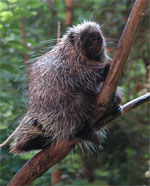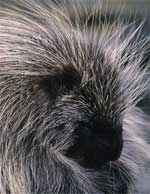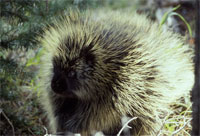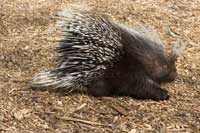|

 Weights and Measures: Most porcupines are about 60-90 cm (25-36 inches) long, with a 20-25 cm (8-10 inch) long tail. Weighing between 5-16 kg (12-35 pounds), they are rounded, large and slow. Porcupines come in various shades of brown, gray, and the unusual white. Weights and Measures: Most porcupines are about 60-90 cm (25-36 inches) long, with a 20-25 cm (8-10 inch) long tail. Weighing between 5-16 kg (12-35 pounds), they are rounded, large and slow. Porcupines come in various shades of brown, gray, and the unusual white.
The Quill is Mightier than the Sword: The porcupine's chief defense is its quills, sharp spines distributed across the rodent's back, sides, legs, tail and head. They may be as dense as 150 per square inch, giving one animal as many as 30,000 quills. Contrary to popular belief, porcupines do not shoot out their quills; unfortunate victims approach closely enough to be swatted by the tail or brush against the animal. Like the related ordinary hairs, porcupine quills grow back when they come out.
 In Self-defense: When threatened, a porcupine will raise its quills. This is the piloerection reflex, the same as the goose bump reflex in humans. A porcupine can defend itself by hiding its bare face from an attacker and keeping its bare belly to the ground. It may swat its tail at an assailant. The quills are not poisoned, but animals may die from a porcupine encounter if the quills prevent eating. Porcupines often fall on their own quills. Likely as an evolutionary result, the quills possess mild antibiotic properties. In Self-defense: When threatened, a porcupine will raise its quills. This is the piloerection reflex, the same as the goose bump reflex in humans. A porcupine can defend itself by hiding its bare face from an attacker and keeping its bare belly to the ground. It may swat its tail at an assailant. The quills are not poisoned, but animals may die from a porcupine encounter if the quills prevent eating. Porcupines often fall on their own quills. Likely as an evolutionary result, the quills possess mild antibiotic properties.
Moving Quills: Quills are sharp-pointed, fitted with microscopic barbs, and expand on contact with warm flesh. Muscle contractions in a quill victim work the quill deeper, as much as 2 cm per day unless the quills are removed promptly.

Where in the World? Porcupines occupy a wide range of habitats in tropical and temperate parts of Asia, Italy, Africa and the Americas. Porcupines live in forests, deserts and grasslands. Some live in trees, others stay on the ground.
Salt Seekers: Porcupines in search of salt sometimes encroach on areas inhabited by people and eat tool handles, clothes and many other items that have been coated in salty sweat.
Just Like Chicken: In parts of Africa, porcupines are eaten as a form of bush meat. Porcupine meat is also appreciated in some regions of Italy and Vietnam.
Twenty-three's a Crowd: A porcupine is any of 23 species of rodent belonging to the families Erethizontidae and Hystricidae. All defend themselves with sharp spines (which are actually modified hairs) rather like those of the hedgehogs, which are part of the order Insectivora and more closely related to shrews and moles than they are to the rodents, and the echidnas, which as monotremes are very distantly related indeed.
Sizes and Scales: Porcupines vary in size considerably: Rothschild's Porcupine of South America weighs less than a kilogram; the African Porcupine can grow to well over 20 kg.
----------------------------------------------------------------------------------------------------------------------------
North American Porcupine (Erethizon dorsatum),
 Second largest: The North American porcupine (Erethizon dorsatum), also known as Canadian Porcupine, is a large rodent in the New World porcupine family. The Beaver is the only other rodent larger than the North American Porcupine found in North America. Second largest: The North American porcupine (Erethizon dorsatum), also known as Canadian Porcupine, is a large rodent in the New World porcupine family. The Beaver is the only other rodent larger than the North American Porcupine found in North America.
Habitat: This animal is usually found in coniferous and mixed forested areas in Canada, Alaska and much of the northern and western United States. They are also found in thicketed areas in shrublands, tundra and deserts as far south as northern Mexico. It makes its den in a hole in a trees or in a rocky area.
Description: Porcupines are usually dark brown in color. They have a chunky body, a small face, short legs and a short thick tail. Their upperparts are covered with thousands of sharp, barbed hollow spines or quills which are used for defense. The quills cannot be thrown, but detach easily and are difficult to remove once lodged in an attacker. The quills are normally flattened against to the body unless the animal is disturbed. The porcupine also swings its quilled tail towards the perceived threat.
Diet: These animals are mainly active at night; on summer days, they often rest in trees. During the summer, they eat twigs, roots, stems, berries and other vegetation. In the winter, they mainly eat conifer needles and tree bark. They do not hibernate but do not travel far from their den in winter.
Breeding: Porcupines breed in the fall and the young porcupine (usually one) is born in the spring with soft quills which harden shortly after birth.
Pest: They are considered by some to be as a pest because of the damage that they often inflict on trees and wooden and leather objects. The quills are used by Native Americans to decorate articles such as baskets and clothing. Some people consider them to be edible. Porcupines do not move very fast and are often hit by vehicles while crossing roads. Natural predators include fishers, wolverines and coyotes.
---------------------------------------------------------------------------------------------------------------------------
African Brush-Tailed Porcupine (Atherurus africanus)
 Description:The African Brush-Tailed Porcupine (Atherurus africanus) is a species of rat-like Old World porcupine called "brush-tailed porcupines". The brush-tailed porcupines live in forests, usually at high elevations. They are nocturnal and during the day they sleep in caves and burrows. The brush-tailed porcupine is one of the biggest rodents in Africa, growing almost three feet long and weigh as much as eight pounds. It has an elongated rat-like face and body and short legs, tipped with clawed and webbed feet. Description:The African Brush-Tailed Porcupine (Atherurus africanus) is a species of rat-like Old World porcupine called "brush-tailed porcupines". The brush-tailed porcupines live in forests, usually at high elevations. They are nocturnal and during the day they sleep in caves and burrows. The brush-tailed porcupine is one of the biggest rodents in Africa, growing almost three feet long and weigh as much as eight pounds. It has an elongated rat-like face and body and short legs, tipped with clawed and webbed feet.
Quills: Unlike most other porcupines, the brush-tailed porcupine has lighter and smaller quills. On the tail, these quills are thinner and brush-like. These can make noise when rattled. Brush-tailed porcupines live in small family groups of about eight members. Different family groups can share resources. When attacked by a predator, the porcupine raises its quills so it looks twice its size, rattles its tail quills, and stomps its feet. As with all porcupines, the brush-tailed porcupine would back into the attacker and inflict damage with its quills.
Diet: The brush-tailed porcupine is mostly herbivorous. When alone eating, the porcupines can be quite nervous. During the breeding season, males and females form pair bonds (just like how people go on dates) to get acquainted. The African brush-tailed porcupine has a long pregnancy compared to other rodents: 110 days at the longest. The young are born well-developed or precocial. Porcupines reach maturity at two years of age.
The meat of the African Brush-tailed Porcupine is very popular and is consumed in large quantities.
-----------------------------------------------------------------------------------------------------------------------------
Species
The 11 Old World porcupines are almost exclusively terrestrial, tend to be fairly large, and have quills that are grouped in clusters. They separated from the other hystricognaths about 30 million years ago, much earlier than the New World porcupines.
The 12 New World porcupines are mostly smaller (although the North American Porcupine reaches about 85 cm in length and 18 kilograms), have their quills attached singly rather than grouped in clusters and are excellent climbers, spending much of their time in trees. The New World porcupines developed their spines independently and are more closely related to several other families of rodent than they are to the Old World porcupines.
ORDER RODENTIA
- Suborder Hystricomorpha
- Infraorder Hystricognathi
- Family Hystricidae: Old World porcupines
- African Brush-tailed Porcupine, Atherurus africanus
- Asiatic Brush-tailed Porcupine, Atherurus macrourus
- African Porcupine, Hystrix cristata
- Cape Porcupine, Hystrix africaeaustralis
- Himalayan Porcupine, Hystrix hodgsoni
- Indian Porcupine, Hystrix indicus
- Malayan Porcupine, Hystrix brachyura
- Bornean Porcupine, Thecurus crassispinis
- Philippine Porcupine, Thecurus pumilis
- Sumatran Porcupine, Thecurus sumatrae
- Long-tailed Porcupine, Trichys fasciculata
- Family Erethizontidae: New World porcupines
- Brazilian Porcupine, Coendou prehensilis
- Bicolor-spined Porcupine, Coendou bicolor
- Koopman's Porcupine, Coendou koopmani
- Rothschild's Porcupine, Coendou rothschildi
- Mexican Tree Porcupine, Sphiggurus mexicanus
- South American Tree Porcupine, Sphiggurus spinosus
- Bahia Hairy Dwarf Porcupine, Sphiggurus insidiosus
- Pallid Hairy Dwarf Porcupine, Sphiggurus pallidus (extinct)
- Brown Hairy Dwarf Porcupine, Sphiggurus vestitus
- Orange-spined Hairy Dwarf Porcupine, Sphiggurus villosus
- North American Porcupine, Erethizon dorsatum
- Stump-tailed Porcupine, Echinoprocta rufescens
- Bristle-spined Porcupine, Chaetomys subspinosus (sometimes considered an echymid)
All text is available under the terms
of the GNU Free Documentation License
|